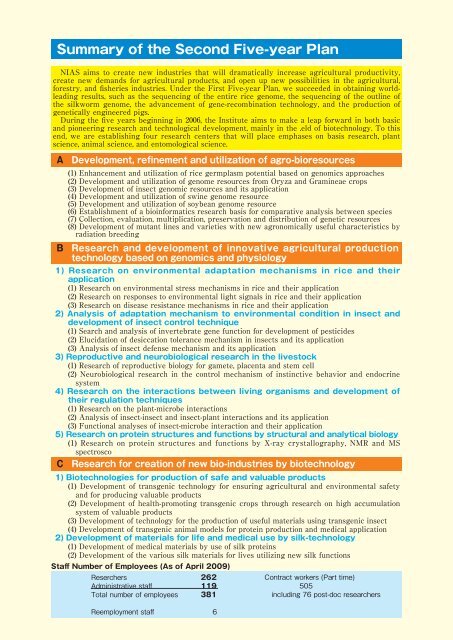Annual Report 2010
Annual Report 2010
Annual Report 2010
You also want an ePaper? Increase the reach of your titles
YUMPU automatically turns print PDFs into web optimized ePapers that Google loves.
Summary of the Second Five-year Plan<br />
NIAS aims to create new industries that will dramatically increase agricultural productivity,<br />
create new demands for agricultural products, and open up new possibilities in the agricultural,<br />
forestry, and fisheries industries. Under the First Five-year Plan, we succeeded in obtaining worldleading<br />
results, such as the sequencing of the entire rice genome, the sequencing of the outline of<br />
the silkworm genome, the advancement of gene-recombination technology, and the production of<br />
genetically engineered pigs.<br />
During the five years beginning in 2006, the Institute aims to make a leap forward in both basic<br />
and pioneering research and technological development, mainly in the .eld of biotechnology. To this<br />
end, we are establishing four research centers that will place emphases on basis research, plant<br />
science, animal science, and entomological science.<br />
A Development, refinement and utilization of agro-bioresources<br />
(1) Enhancement and utilization of rice germplasm potential based on genomics approaches<br />
(2) Development and utilization of genome resources from Oryza and Gramineae crops<br />
(3) Development of insect genomic resources and its application<br />
(4) Development and utilization of swine genome resource<br />
(5) Development and utilization of soybean genome resource<br />
(6) Establishment of a bioinformatics research basis for comparative analysis between species<br />
(7) Collection, evaluation, multiplication, preservation and distribution of genetic resources<br />
(8) Development of mutant lines and varieties with new agronomically useful characteristics by<br />
radiation breeding<br />
B Research and development of innovative agricultural production<br />
technology based on genomics and physiology<br />
1) Research on environmental adaptation mechanisms in rice and their<br />
application<br />
(1) Research on environmental stress mechanisms in rice and their application<br />
(2) Research on responses to environmental light signals in rice and their application<br />
(3) Research on disease resistance mechanisms in rice and their application<br />
2) Analysis of adaptation mechanism to environmental condition in insect and<br />
development of insect control technique<br />
(1) Search and analysis of invertebrate gene function for development of pesticides<br />
(2) Elucidation of desiccation tolerance mechanism in insects and its application<br />
(3) Analysis of insect defense mechanism and its application<br />
3) Reproductive and neurobiological research in the livestock<br />
(1) Research of reproductive biology for gamete, placenta and stem cell<br />
(2) Neurobiological research in the control mechanism of instinctive behavior and endocrine<br />
system<br />
4) Research on the interactions between living organisms and development of<br />
their regulation techniques<br />
(1) Research on the plant-microbe interactions<br />
(2) Analysis of insect-insect and insect-plant interactions and its application<br />
(3) Functional analyses of insect-microbe interaction and their application<br />
5) Research on protein structures and functions by structural and analytical biology<br />
(1) Research on protein structures and functions by X-ray crystallography, NMR and MS<br />
spectrosco<br />
C Research for creation of new bio-industries by biotechnology<br />
1) Biotechnologies for production of safe and valuable products<br />
(1) Development of transgenic technology for ensuring agricultural and environmental safety<br />
and for producing valuable products<br />
(2) Development of health-promoting transgenic crops through research on high accumulation<br />
system of valuable products<br />
(3) Development of technology for the production of useful materials using transgenic insect<br />
(4) Development of transgenic animal models for protein production and medical application<br />
2) Development of materials for life and medical use by silk-technology<br />
(1) Development of medical materials by use of silk proteins<br />
(2) Development of the various silk materials for lives utilizing new silk functions<br />
Staff Number of Employees (As of April 2009)<br />
Reserchers 262<br />
Administrative staff 119<br />
Total number of employees 381<br />
Reemployment staff 6<br />
Contract workers (Part time)<br />
505<br />
including 76 post-doc researchers













